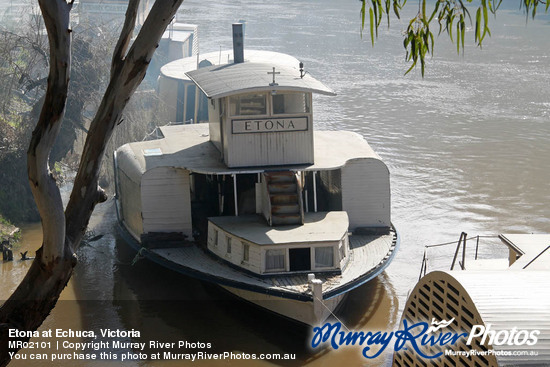
The second 'Etona' was planned and built in 1898
This is the second vessel with the same name of Etona : The first Etona was a propeller driven steam launch it's owners in those days were the South Australian Police Force. Her name then was the 'Patroller'. She bad seen service as a police launch at Port Adelaide, South Australia.
It was also used by the Police launch was eventually sold. The Murray River Mission Boat fund was set up by the Church of England (Australia) funds were raised and the launch was bought for about 110 pounds ($220). The boat was transported to Goolwa by rail, and new fittings, cabins, alterations and repairs raised the initial cost to 188 pounds ($376). The steam launch was named 'Etona' on 12th June 1891. Then her missionary life had began. By 1897 she was showing the effects of six years of hard work and eventually the mission decided to sell the vessel. The old Etona was re-named 'Alma'.
The second 'Etona' was planned and built in 1898-when Dr. Harmer was Bishop of Adelaide. By coincidence, he too was an old Etonian (a person who studied at the Eton College, England). Fund gathering was organised about the start of the year, and some donations from England did arrive ($104) to help pay for the new paddle steamer, as indeed funds often carne for other worthy church causes too. The new paddle steamer was to cost almost ten times as much as the first steam launch.
Her total cost when completed was estimated to approach 1000 pounds ($2,000).The paddJe steamer 'Etona' was designed by Mr David Milne of Morgan. And was built at Milang under the superintendence of the engineer, Mr McLellan, Who also made himself responsible for the deckhouses. Her construction started at about November, 1898 and the hull was in the water before Christmas.
By the time the engines arrived and had been installed, a further six or seven months had passed. Her upper deckhouse consisted only of a flat roofed wheelhouse supported by stanchions (supports). The familiar wheelhouse and cabin which makes her outline so distinctive was apparently added wlfuin a short time, so too was the windshield protecting the engine room. Her dimensions are 60ft long. 12ft wide. 4 1 /2 ft. (18.3m x 4.3m x 1.5m) depth of hold, and drawing under 2ft of water (62cm). Measuring under 40 ton gross. She is provided with a Lomoor boiler, and double cylinder high pressure engines, 8 horsepower, geared, 3 to 1 by a Hans-Renolds silent chain belt to the shaft, making her 24 horsepower effective, and driving her at 9 miles (18 falls) per hour in still water with 60lbs (27 kgs) of steam power.
The engines are made by Ransome, Sims and Jefferies, of Ipswich, supplied by their agents, Messrs. J.S. Bagshaw and sons of Adelaide. Her frame is of angle Iron, covered with 2" (50mm) thlck jarrah (wood), with galvanised steel topsides.
By 1912, churches had been constructed at a number of the towns visited by the 'Etona' (2) and she was retired and sold to Captain A.H. Conner. Conner laid her up in about 1944. In 1961, a group of people purchased her and steamed her to Echuca.
Then they restored her to near original condition later she was sold again to Mr Phil Symons, a chemist of Echuca.
Tell your friends you found this at murrayriver.com.au!
Copyright Discover Murray 2026. This site or any portion of this site must not be reproduced, duplicated, copied, sold, resold, or otherwise exploited for any commercial purpose that is not expressly permitted by DISCOVER MURRAY.






 Amy Shark The Solo Acoustic "Songs & Stories" Tour
Amy Shark The Solo Acoustic "Songs & Stories" Tour Lee Kernaghan Boys From The Bush The Concert
Lee Kernaghan Boys From The Bush The Concert The Australian Beach Boys Show
The Australian Beach Boys Show Kevin Bloody Wilson Aussie Icon Tour with special guest Jenny Talia
Kevin Bloody Wilson Aussie Icon Tour with special guest Jenny Talia Little By Little
Little By Little
